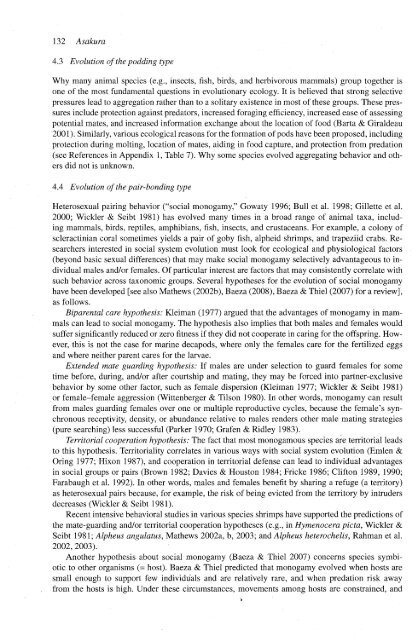Decapod Crustacean Phylogenetics - AToL Decapoda - Natural ...
Decapod Crustacean Phylogenetics - AToL Decapoda - Natural ...
Decapod Crustacean Phylogenetics - AToL Decapoda - Natural ...
You also want an ePaper? Increase the reach of your titles
YUMPU automatically turns print PDFs into web optimized ePapers that Google loves.
132 Asakura<br />
4.3 Evolution of the podding type<br />
Why many animal species (e.g., insects, fish, birds, and herbivorous mammals) group together is<br />
one of the most fundamental questions in evolutionary ecology. It is believed that strong selective<br />
pressures lead to aggregation rather than to a solitary existence in most of these groups. These pressures<br />
include protection against predators, increased foraging efficiency, increased ease of assessing<br />
potential mates, and increased information exchange about the location of food (Barta & Giraldeau<br />
2001). Similarly, various ecological reasons for the formation of pods have been proposed, including<br />
protection during molting, location of mates, aiding in food capture, and protection from predation<br />
(see References in Appendix 1, Table 7). Why some species evolved aggregating behavior and others<br />
did not is unknown.<br />
4.4 Evolution of the pair-bonding type<br />
Heterosexual pairing behavior ("social monogamy," Gowaty 1996; Bull et al. 1998; Gillette et al.<br />
2000; Wickler & Seibt 1981) has evolved many times in a broad range of animal taxa, including<br />
mammals, birds, reptiles, amphibians, fish, insects, and crustaceans. For example, a colony of<br />
scleractinian coral sometimes yields a pair of goby fish, alpheid shrimps, and trapeziid crabs. Researchers<br />
interested in social system evolution must look for ecological and physiological factors<br />
(beyond basic sexual differences) that may make social monogamy selectively advantageous to individual<br />
males and/or females. Of particular interest are factors that may consistently correlate with<br />
such behavior across taxonomic groups. Several hypotheses for the evolution of social monogamy<br />
have been developed [see also Mathews (2002b), Baeza (2008), Baeza & Thiel (2007) for a review],<br />
as follows.<br />
Biparental care hypothesis: Kleiman (1977) argued that the advantages of monogamy in mammals<br />
can lead to social monogamy. The hypothesis also implies that both males and females would<br />
suffer significantly reduced or zero fitness if they did not cooperate in caring for the offspring. However,<br />
this is not the case for marine decapods, where only the females care for the fertilized eggs<br />
and where neither parent cares for the larvae.<br />
Extended mate guarding hypothesis: If males are under selection to guard females for some<br />
time before, during, and/or after courtship and mating, they may be forced into partner-exclusive<br />
behavior by some other factor, such as female dispersion (Kleiman 1977; Wickler & Seibt 1981)<br />
or female-female aggression (Wittenberger & Tilson 1980). In other words, monogamy can result<br />
from males guarding females over one or multiple reproductive cycles, because the female's synchronous<br />
receptivity, density, or abundance relative to males renders other male mating strategies<br />
(pure searching) less successful (Parker 1970; Grafen & Ridley 1983).<br />
Territorial cooperation hypothesis: The fact that most monogamous species are territorial leads<br />
to this hypothesis. Territoriality correlates in various ways with social system evolution (Emlen &<br />
Oring 1977; Hixon 1987), and cooperation in territorial defense can lead to individual advantages<br />
in social groups or pairs (Brown 1982; Davies & Houston 1984; Fricke 1986; Clifton 1989, 1990;<br />
Farabaugh et al. 1992). In other words, males and females benefit by sharing a refuge (a territory)<br />
as heterosexual pairs because, for example, the risk of being evicted from the territory by intruders<br />
decreases (Wickler & Seibt 1981).<br />
Recent intensive behavioral studies in various species shrimps have supported the predictions of<br />
the mate-guarding and/or territorial cooperation hypotheses (e.g., in Hymenocera picta, Wickler &<br />
Seibt 1981; Alpheus angulatus, Mathews 2002a, b, 2003; and Alpheus heterochelis, Rahman et al.<br />
2002,2003).<br />
Another hypothesis about social monogamy (Baeza & Thiel 2007) concerns species symbiotic<br />
to other organisms (= host). Baeza & Thiel predicted that monogamy evolved when hosts are<br />
small enough to support few individuals and are relatively rare, and when predation risk away<br />
from the hosts is high. Under these circumstances, movements among hosts are constrained, and

















